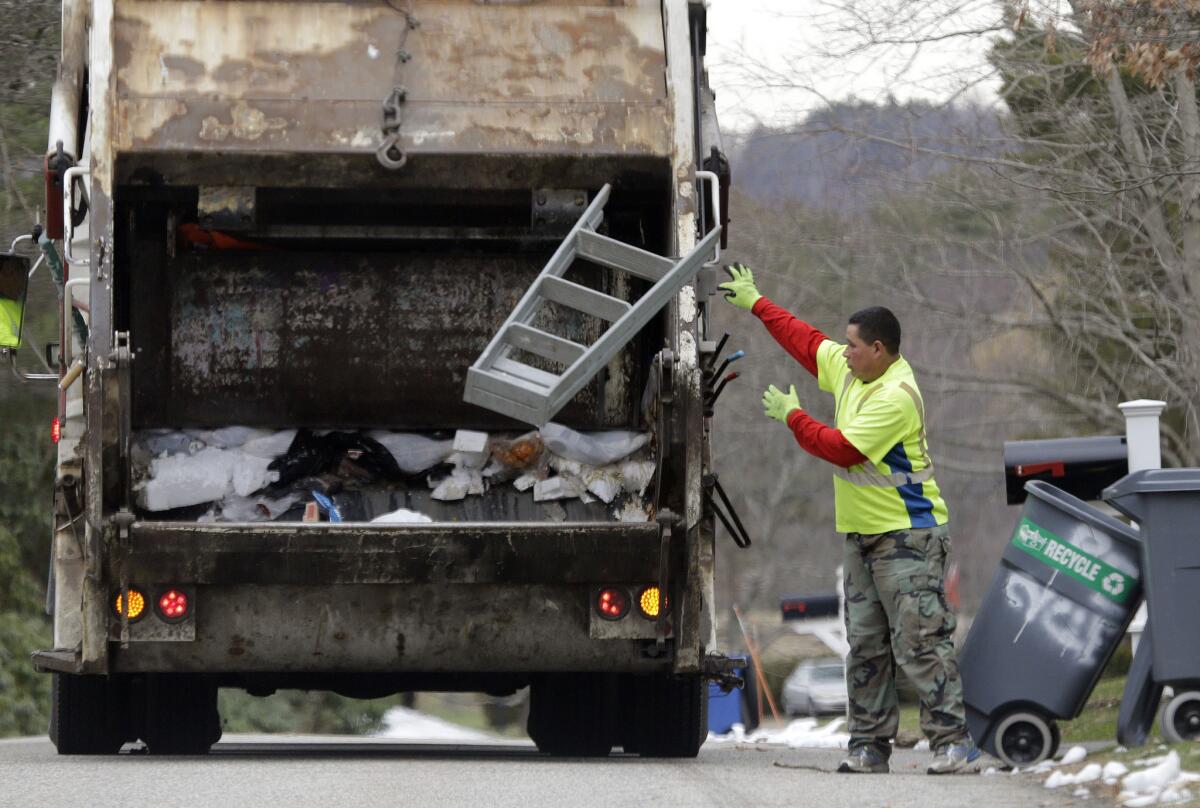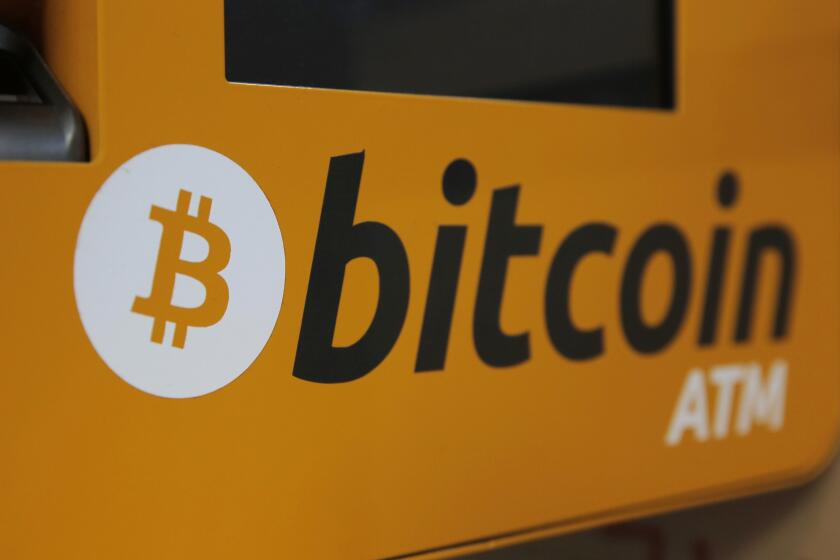Why American workers aren’t changing jobs, and what it means for the economy

A sanitation worker throws a stepladder into his truck in North Andover, Mass., on March 23. On Friday, April 1, the government issued the U.S. jobs report for March.
Reporting from Washington — Despite steady job growth and a low unemployment rate, the U.S. recovery is trailing in one key aspect: the kind of labor market dynamism that played a large role in making the country the world’s economic superpower.
One telltale sign is that workers are changing jobs at a slower pace than before. Another is that there’s been a long decline in the number of new, innovative firms that powered job creation in the past.
Short term, this slowdown in the so-called churning of jobs could be an indication that employment has stabilized for the better. After all, during the second half of the 20th century, when the country achieved levels of growth and prosperity greater than at any time in its history, workers commonly stayed with the same employer for years.
But longer term, economists worry that the lower turnover is an indication of stagnation, not stability: Workers are staying put because there are fewer better jobs to move to, or they face other barriers that are keeping them locked in their current positions. And with declining job movement may come slower gains in overall employment, wages, productivity and, ultimately, economic growth.
Job openings and new hires have both picked up in the past two years as the labor market has improved, but the rate at which people are moving in and out of jobs has been in a long, steady decline.
In the 1990s, for example, for every 100 workers in the labor force, about six of them took on new jobs every quarter and 5.5 left their jobs during the same period.
Since the Great Recession in late 2007, an average of 4.5 out of every 100 people in the labor force have moved into new jobs every quarter, while 4.4 separated from their existing positions, according to an analysis of government data by W. Michael Cox, former chief economist at the Federal Reserve Bank of Dallas.
“We’re slowing down, we’re following the path downward in terms of job dynamism,” said Cox, who now teaches at Southern Methodist University.
Two other related trends point to a similar conclusion: The formation of new companies, which are relatively big generators of jobs and reflect a dynamic, forward-looking business climate, has slowed down significantly over the years.
See more of our top stories on Facebook >>
New firms, or those less than a year old, accounted for about 13% of all companies in the late 1980s, but that has since declined to about 8% in recent years. Making matters worse, a small but significant part of the drop-off has come from start-ups with the fastest growth and highest job creation, according to a recent paper from the National Bureau of Economic Research.
“Evidence shows that high-growth young firms have disproportionately accounted for job creation and productivity growth,” the researchers wrote. “Now the U.S. has a much lower pace of start-ups, and those that do enter are less likely to be high-growth firms.”
That could be one of the reasons people also are not moving across labor markets as they once did. Census Bureau data show that the annual rate at which people relocated to a different state -- which is often an indicator of job changes -- fell to between 1.4% and 1.7% of the overall population since the Great Recession. That contrasts to interstate migration rates at or close to 3% from 1947 through the middle of the last decade, with only a few exceptions.
To be sure, the aging of the U.S. population accounts for part of this slowdown. Older people are less mobile and less likely to switch jobs, too. And baby boomers like Cara Black and her husband, who didn’t want to be identified, often face difficulties when they are trying to find new jobs.
The south Orange County resident thinks age discrimination is a factor in her husband’s inability to land a job despite a master’s degree and two years of looking after leaving his job at a dental care company. “I worry quite a bit about our situation,” she said.
It isn’t just older workers. The slowdown in labor dynamism cuts across demographics as well as industry, according to Federal Reserve and private economists.
Josiah Kadle, who lives near Harrisonburg, Va., left his phlebotomy job in March after being recruited by an acquaintance in property management. But the 31-year-old said he would have switched jobs earlier had he seen openings that paid more.
Over two years he searched and searched. But in his area in Northern Virginia, the pay for blood-draw specialists was pretty much the same everywhere, Kadle said, and with a wife who is working, two small children and a house, moving out of the region wasn’t an option.
“When I was looking, there wasn’t much out there in this market. Wages have been stagnant,” he said.
Experts also blame government policies for suppressing job creation and labor market mobility, whether through taxes or burdensome regulations.
Government restrictions on who can work in which jobs have expanded greatly over time, said academic economists Steven Davis and John Haltiwanger, who have written extensively on labor market flows. Citing other research, they note that the share of workers required to have a government-issued license to do their jobs rose from less than 5% in the 1950s to 29% in 2008. Even librarians and funeral workers today must be licensed in some states.
Taken together, the slowdown in job-to-job movement, geographical mobility and new firm formation has economists worried that the U.S. may be losing something called “creative destruction.”
The term, coined by the influential economist Joseph Schumpeter in the early 20th century, describes the idea that a healthy market-driven capitalist system grows bigger and stronger because it is constantly creating better companies and products while destroying older ones that are falling behind the curve of progress.
In this view, the pace of job creation and destruction has long been a hallmark of the American economic vitality. While painful for some people at some points, it produces more good in the long run.
The nation’s energetic and flexible labor market, compared with other countries, is considered a major reason why the U.S. economy has continued to outperform almost all others over time.
But what Schumpeter called this “gale of creative destruction” has turned into something more of a breeze in the U.S., raising concerns about the underlying vigor and productive future of the economy.
At least for the immediate future, lower job churn may seem like a good thing. It can mean less uncertainty for workers. It also could reduce costs for employers who don’t have to spend as much for hiring and training new workers.
Some analysts wonder whether the Internet and other hiring and job-finding tools have helped make better matches between workers and jobs, resulting in less turnover. But many economists don’t view the decline in job flows as benign or inconsequential.
Sophia Koropeckyj, a labor economist at Moody’s Analytics, sees a potentially vicious cycle at work. If people are staying in their jobs longer and not acquiring more skills, they are not only less likely to earn higher wages, but also not freeing up jobs for others.
“It’s a big deal,” said Davis, a professor at the University of Chicago Booth School of Business and expert on the subject. “For many workers, the way they build careers involves a lot of mobility, especially early in their career. On balance, it’s harder for someone to enter the job market … to move up, improve skills and raise their pay.”
Follow me on Twitter @dleelatimes
MORE FROM BUSINESS
April Fools’ Day: Trader Joe’s, Adobe, Lexus and more
U.S. auto sales report big numbers, best month in 10 years
Yamashiro may get booted from its Hollywood Hills building for something more upscale
More to Read
Inside the business of entertainment
The Wide Shot brings you news, analysis and insights on everything from streaming wars to production — and what it all means for the future.
You may occasionally receive promotional content from the Los Angeles Times.











